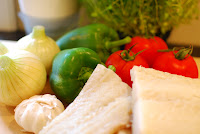
September is the month when farmers in Norway bring their sheep down from their summer grazing pastures high up in the majestic mountains. The sheep have spent this time eating grass that is often intermingled with wild herbs. This has the effect of imparting such a wonderfully mild and fragrant aroma to the meat. As a result, Norwegian lamb is some of the best I have ever tasted.
There's nothing better to celebrate this wonderful bounty than making fårikål, a traditional Norwegian meal of lamb and cabbage (in fact the name, "får i kål", means just that - "sheep in cabbage"), which was voted the country's national dish in a radio programme in the 1970s. In fact, the last Thursday of September is Fårikålens Festdag (Fårikål Feast Day), and Norwegians celebrate this day by making this simple, but delicious dish. Such is their passion for this dish that Norwegians even have a National Fårikål Society, which opines on all things fårikål.
Fårikål is made from just two main ingredients: cabbage and lamb, but you can also use mutton instead (the older the animal, the stronger the taste). Therefore, the quality of each is imperative. The meat should be taken from the shoulder, neck or shank and should always be left on the bone and include some fat, which will soak into the cabbage, making them meltingly tender. The cabbage should be the best quality green cabbage you can find. Don't be tempted to use fancier varieties such as Savoy – fårikål is not a pretty dish, but what it lacks in visual appeal, it more than makes up for in flavour. This is one of those dishes that benefits from a day or two maturing in the fridge after you have made it, so make sure you make extra to save for later.
Traditionally, fårikål is served with boiled potatoes, deliciously thin and crisp Norwegian flatbrød (flat bread), and homemade lingonberry jam (just lingonberries and sugar mashed up, no cooking needed). The pan juices at the bottom of the casserole should be pored over the top of the lamb, as the water we added earlier will now have transformed itself into a rich and hearty lamb broth. You can pick out the whole peppercorns later if you like, but hardcore fårikål lovers will munch on these and think you a wimp if you do otherwise! Fårikål is best served with a glass of dark ale, or perhaps some fiery akevitt. It is a perfect warm, rib-sticking meal to have after spending the day walking in the mountains.
This recipe for fårikål comes courtesy of Grandma Nibbler, who made the delicious food you can see in the photo above (my inferior attempt can be seen in the photos below) - she even made her own flatbrød and lingonberry jam. However, I think she was somewhat bemused when I asked to take photos of the finished dish.
Ingredients (serves 6)
- 2 ½ kg lamb/hogget/mutton on the bone (shoulder, shank or neck) cut into 3cm slices
- 2 ½ kg green cabbage
- 500ml water
- 6 tsp whole black peppercorns
- Salt, to taste (about 3 tsp or so)
- Cut the cabbage into quarters down the core and cut each quarter into 3-4 wedges (the idea is to keep part of the core on each segment, which will hold the leaves together and prevent the whole thing disintegrating while cooking).
- Pour the water into a large casserole pot. Place a layer of lamb, then a layer of cabbage into the pot, seasoning each layer with salt and some of the whole peppercorns as you go.
- Repeat this layering process until you have used up all the ingredients. The final layer on the top should always be cabbage.
- Cover tightly and bring to the boil
- Simmer over a very low heat for 2-3 hours until the lamb is really tender and falling off the bone (check the water level now and then, making sure the pan doesn't run dry).
- Serve on warmed plates with boiled potatoes, flatbrød, and homemade lingonberry jam. The juices in the bottom of the pot make an excellent gravy.








.jpeg)










































